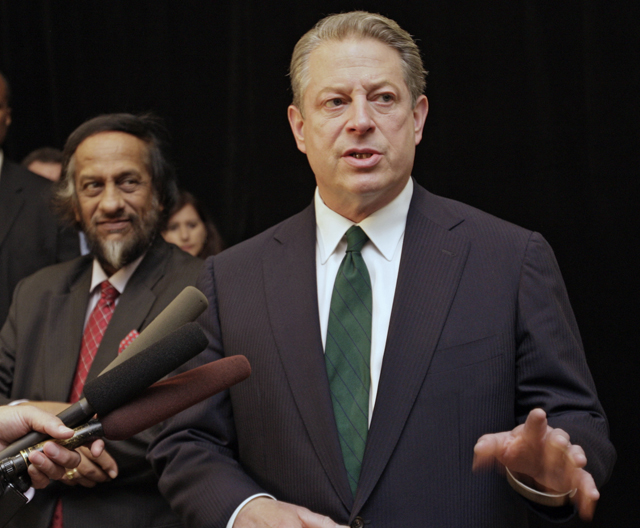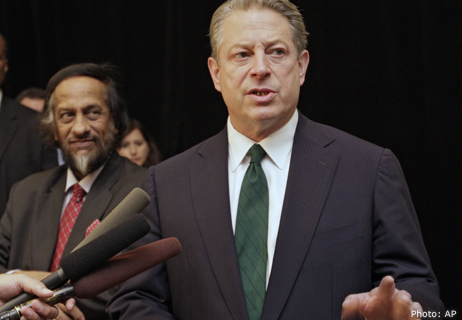 Gore and R.K. Pachauri, head of the International Panel on Climate Change, talk with the media at the May gathering of The Climate Project in Nashville.Associated Press photo
Gore and R.K. Pachauri, head of the International Panel on Climate Change, talk with the media at the May gathering of The Climate Project in Nashville.Associated Press photo
Al Gore is drawing lessons from the Obama campaign as he works to rally support for the Waxman-Markey climate and energy bill.
While the environmental movement will never have the cash of ExxonMobil and its fossil-fuel friends, it does have legions of grassroots supporters. Gore’s two groups — the Alliance for Climate Protection and The Climate Project — are putting thousands of “boots on the ground” in key congressional districts around the country to help build momentum for climate legislation.
“In order to win this struggle, we have to go to the constituents of the Congress,” Gore told Grist recently. “Just laying the facts on the table and playing an inside-the-Beltway game is not going to do it on this issue. We have to win the feelings and opinions of voters in the country as a whole … We have to go to the grassroots.”
Gore founded the Alliance for Climate Protection and The Climate Project in 2006 with money he earned from An Inconvenient Truth and other ventures. He’s built them into “multi-hundred-million-dollar” organizations “aimed at getting the facts before the people,” he told Grist. Up to this point, their work has been largely separate: The Climate Project has trained 2,600 people to present versions of Gore’s famous slideshow, while the Alliance has run major advertising campaigns to convince Americans of the need to address the climate crisis.
But now the two groups are coordinating closely as they enter a new campaign-style phase with a focused mission: passing a solid climate bill.
The plan, according to Alliance CEO Maggie Fox, is to organize “the biggest mobilization that the climate movement has ever seen.”
Getting into the field
Fox came to the Alliance in March from America Votes, a coalition of progressive groups that coordinates get-out-the-vote drives in swing states. She replaced Cathy Zoi, who left to join the Obama administration as assistant secretary for energy efficiency and renewable energy.
The Alliance recently brought on other veterans of national political campaigns: Steve Hildebrand, the Obama campaign’s deputy national campaign director, is working as a consultant for the project. Steve Bouchard, a veteran of the 2004 and 2008 Democratic presidential campaigns, is campaign manager for the Alliance. Brian Rogers, spokesperson for John McCain’s presidential campaign last year, has come on board as research director.
The group is hiring a fleet of veteran field organizers who cut their teeth during the Obama campaign, and who bring a wealth of grassroots organizing skills. Since the beginning of the year, the group’s paid staff has grown from 20 people to 120, with plans to expand up to 250 in the next few months. The Alliance has moved its headquarters from California to Washington, D.C., but at the same time sent many of its organizers far outside the Beltway. New hires include 16 state directors and 55 regional field organizers, working in a total of 28 states, with a particular emphasis on the districts of swing-vote representatives in the Midwest and South who need encouragement to support climate legislation.
The group’s annual budget hasn’t changed — it’s still in the range of $80 million to $100 million, Fox confirms — but now, instead of spending the bulk of its money on big ad campaigns, it’s dividing funds between advertising and on-the-ground staff.
“We know we can’t win this through just paid media,” said Bouchard. “The idea was to develop a comprehensive campaign, just like you would in any electoral context.”
“If we’re going to make a difference, it’s going to be in people’s congressional districts and people’s states,” said Hildebrand. “What happens in Washington oftentimes is very important, but where we’re going to apply pressure is back home. I wish everyone in the environmental community would empty out their offices in Washington and ship them back to these states and districts to create a lot of noise.”
Fox, citing lessons learned in her time with America Votes, notes the importance of spreading organizers out to crucial districts. The Alliance has been coordinating with partners from environmental, labor, religious, and progressive groups to figure out which areas are already covered and which need people on the ground.
“It’s not just that you have to agree on the elements of a legislative package,” said Fox. “What we are agreeing on now is how to cover the map, how to engage, involve, and reach out to constituencies across the map.”
Rallying the troops
Hildebrand touts a community-organizing model — which was quite successful for his former boss last year.
“The big lesson from the Obama campaign is let people help develop their destiny,” said Hildebrand. “Everybody knows how to be active in their community. You don’t have to teach them, you don’t have to hand-hold them. You need to give them encouragement, you need to make sure they buy into what the mission is, and they will go to town, and they will do the job that you need them to do.”
As in an electoral campaign, the paid Alliance staff have expectations each day, including how many phone calls, letters to the editor, and press events they’re supposed to generate or organize.
“You need to create noise, you need to get calls into these members’ offices, demand meetings,” said Hildebrand.
The Alliance has a large pool of supporters to call into action, including an email list of 2.3 million, more than double the number of names it had a year ago. The group is encouraging volunteers within its network to gather community members in a room, talk about the importance of passing climate legislation, and start assigning jobs: a phone-bank captain, a letter-to-the-editor captain, a scheduler, a press person, a community-outreach leader.
Alliance organizers don’t want their troops to delve too deeply into the specifics of climate policy, like how deep emissions cut should be or what percentage of power should be drawn from renewables. They’re focusing on a straightforward goal, according to Fox: “Bold climate action this year.” And right now that means supporting the Waxman-Markey climate bill, “even if the prettiness of it is not what I might want or you might want or the vice president might want,” said Fox.
This approach has already started paying off. In the weeks leading up a critical vote in the House Energy and Commerce Committee on the bill, the Alliance’s network of activists sent 20,000 letters to 960 newspapers in key congressional districts, according to Fox. The Alliance also hosted more than 30 town hall meetings in the districts of committee members. The committee passed the bill on May 21.
This week, during Congress’ Memorial Day recess, Alliance organizers are coordinating another 30 or so town halls to draw attention to the issue of climate change while representatives are in their home districts.
As debate over climate legislation moves forward in Congress, the Alliance is building a “legislative war room” that can do rapid response, sending out action alerts and directives to supporters around the country.
A slideshow, reborn
Gore’s other group, The Climate Project, is proving a critical partner in these efforts. It has trained 1,200 volunteers in the U.S. and 2,600 worldwide over the past two and half years to deliver the slideshow on global warming that Gore made famous in An Inconvenient Truth. These activists have reached 5 million people through 50,000 presentations.
Now, in a new phase of the project kicked off at its North American summit in Nashville, Tenn., earlier this month, Climate Project volunteers will be pushing for a climate bill — and using a retooled slideshow to do it.
“Phase two is entering into a more activism phase, an issue campaign to give them the tools and other information that they’re going to need to go forth and increase public engagement in this issue,” Jenny Clad, executive director of The Climate Project, told Grist at the summit. “One hundred percent of the people here will be pushing for the toughest, strongest climate legislation that we can possibly pass in this country.”
The climate presenters have been successful so far because they use “peer-to-peer persuasion,” said Clad. “[People] are more likely to be persuaded by people that they go to church with, go to school with, work with. They are more likely to listen to this person when they say ‘We’ve got to listen and start doing something’ than they are perhaps to great scientists and icons when they say it.”
Press wasn’t permitted to see the new slideshow yet, but summit attendees report that it includes updated (and scarier) climate science data, as well as new info about the technological and legislative solutions that could help address the problem. The new presentation, said Clad, is “not just how do we change light bulbs, but how do we change laws as well.”
Storming the airwaves
Though there’s a new emphasis on grassroots engagement, the Climate Alliance isn’t abandoning its ad campaigns.
Its best-known advertising blitz was the “We Can Solve It” campaign, with the memorable ad featuring Democratic House Speaker Nancy Pelosi and former Republican House Speaker Newt Gingrich sitting together on a couch and calling for climate action. In November 2008, the Alliance launched its Repower America campaign supporting Gore’s call to shift to 100 percent clean energy in 10 years.
The group recently ran a new set of Repower America TV ads around the country, calling on 14 swing-vote legislators on the Energy and Commerce Committee to support the Waxman-Markey bill — and 10 out of 14 did, voting to pass it out of committee last week. Another ad currently airing on national cable features a blue-collar worker asking Congress to take on the “big oil boys” and support clean energy.
With all these efforts combined, Gore and his team are confident they’ll be able to influence the debate at least as much as dirty energy interests have thus far.
“They have their billions and billions of dollars in record profits … We don’t think we’ll ever compete head to head,” said Hildebrand. “We just have enough to create the kind of noise that’s really needed to get something serious done.”
—–
Watch Repower America ads:


